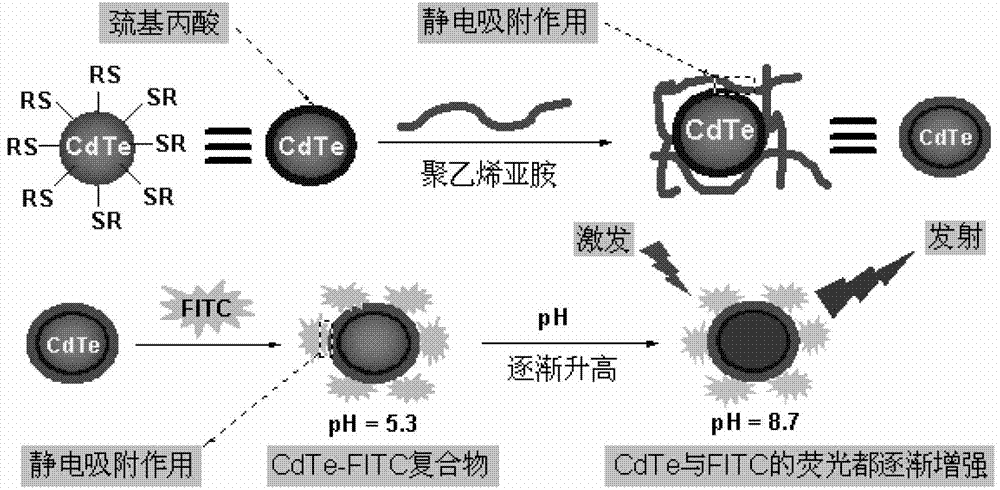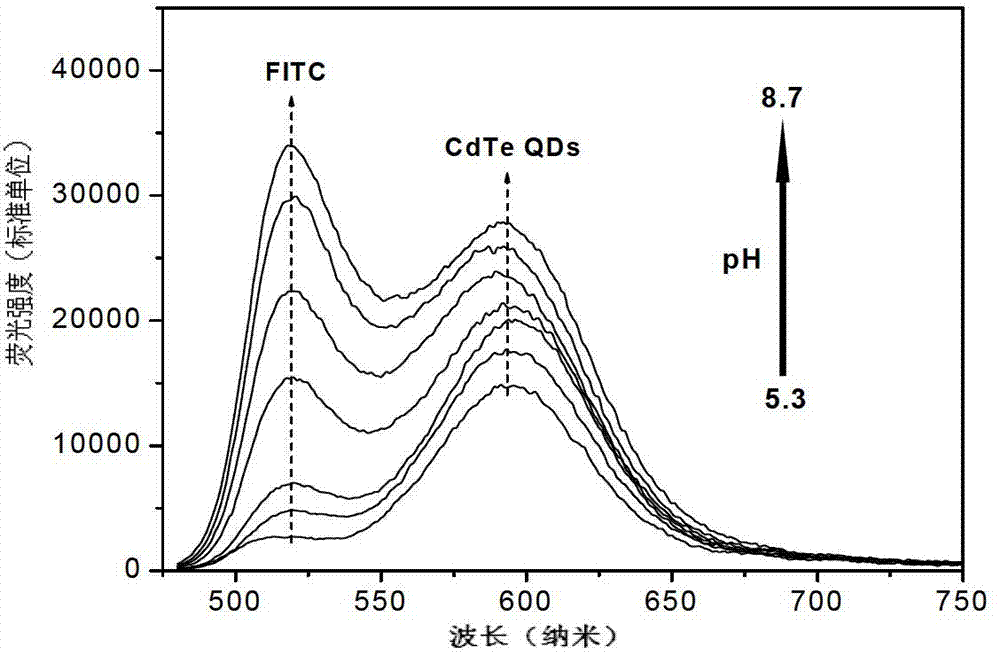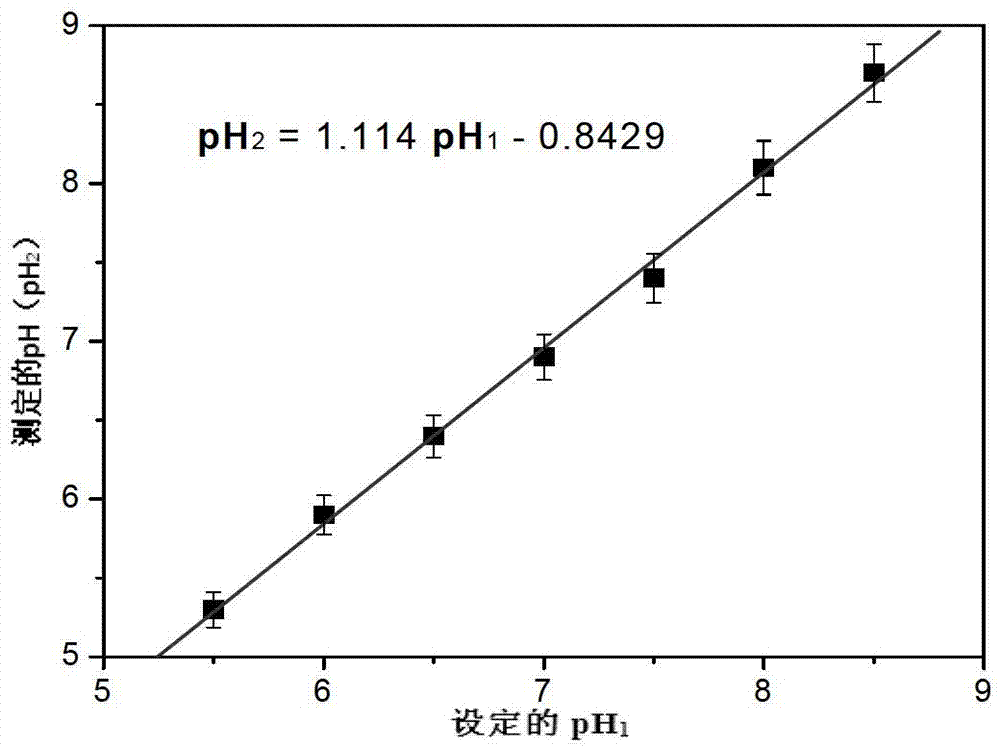Manufacturing method of pH ratio fluorescence probe based on organic dye-quantum dot compound
A ratiometric fluorescent probe, organic dye technology, applied in fluorescence/phosphorescence, luminescent materials, material excitation analysis, etc., can solve problems such as pH ratio fluorescent probes that have not yet been seen, and achieve the effects of fast detection, low cost, and simple method
- Summary
- Abstract
- Description
- Claims
- Application Information
AI Technical Summary
Problems solved by technology
Method used
Image
Examples
Embodiment 1
[0024] The preparation process of pH ratiometric fluorescent probe based on FITC-CdTe complex can be found in figure 1 , the detailed preparation steps are as follows: first, use ultra-pure water to prepare the CdTe QDs solution (50nM) stabilized with thioglycolic acid, that is, in N 2 Atmosphere, magnetic stirring and alkaline aqueous solution, cadmium chloride, sodium telluride hydride, and thioglycolic acid are mixed in a molar ratio of 1:2:4, and the pH is adjusted to 10~12 by 1M NaOH solution, and the reaction is refluxed for 3~ After 6 hours, cadmium telluride quantum dots (CdTe QDs) stabilized with thioglycolic acid were prepared, and a certain amount of polyethyleneimine (PEI) was weighed and dissolved in ultrapure water, and the mass fraction was adjusted to 1%. Then, under room temperature and slow magnetic stirring, the PEI solution was added dropwise to the QDs solution, and PEI-modified QDs were formed by electrostatic adsorption, and the molar concentration of QD...
Embodiment 2
[0027] First, thioglycolic acid-stabilized CdTe QDs solution (50nM) was prepared in ultrapure water, that is, in N 2Atmosphere, magnetic stirring and alkaline aqueous solution, cadmium chloride, sodium telluride hydride, and thioglycolic acid are mixed in a molar ratio of 1:10:20, and the pH is adjusted to 10-12 by 1M NaOH solution, and the reaction is refluxed for 3- After 6 hours, cadmium telluride quantum dots (CdTe QDs) stabilized with thioglycolic acid were prepared, and a certain amount of polyethyleneimine (PEI) was weighed and dissolved in ultrapure water, and the mass fraction was adjusted to 1%. Then, under room temperature and slow magnetic stirring, the PEI solution was added dropwise to the QDs solution, and PEI-modified QDs were formed by electrostatic adsorption, and the molar concentration of QDs and the mass fraction of PEI were controlled to 40nM and 0.1%, respectively. Next, a certain amount of FITC was weighed and dissolved in ultrapure water, and the conce...
Embodiment 3
[0030] First, a thioglycolic acid-stabilized CdTe QDs solution (100 nM) was prepared in ultrapure water, and a certain amount of polyethyleneimine (PEI) was weighed and dissolved in ultrapure water, and the mass fraction was adjusted to 1%. Then, under room temperature and slow magnetic stirring, the PEI solution was added dropwise to the QDs solution, and PEI-modified QDs were formed by electrostatic adsorption, and the molar concentration of QDs and the mass fraction of PEI were controlled at 80nM and 0.1%, respectively. Next, a certain amount of FITC was weighed and dissolved in ultrapure water, and the concentration was adjusted to 150nM. At room temperature and under slow magnetic stirring, the FITC solution was added dropwise to the PEI-modified QDs solution to form a FITC-QDs composite by electrostatic adsorption. The molar concentrations of QDs and FITC were 60nM and 120nM, respectively. Finally, 10mM phosphate buffer solution (PBS) was used to adjust the pH of the com...
PUM
 Login to View More
Login to View More Abstract
Description
Claims
Application Information
 Login to View More
Login to View More - R&D
- Intellectual Property
- Life Sciences
- Materials
- Tech Scout
- Unparalleled Data Quality
- Higher Quality Content
- 60% Fewer Hallucinations
Browse by: Latest US Patents, China's latest patents, Technical Efficacy Thesaurus, Application Domain, Technology Topic, Popular Technical Reports.
© 2025 PatSnap. All rights reserved.Legal|Privacy policy|Modern Slavery Act Transparency Statement|Sitemap|About US| Contact US: help@patsnap.com



